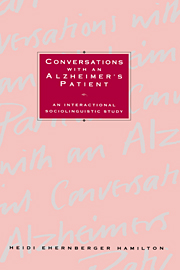5 - Conclusions and implications
Published online by Cambridge University Press: 27 March 2010
Summary
In the fall of 1981, Elsie issued requests, expressed wishes, asked for information and clarification, expressed concern for others, provided excuses for her unexpected behavior, and refused offers - all by use of linguistic means. In the spring of 1986, she not once initiated an exchange verbally, but only responded to my utterances, agreeing with them (mhm), requesting repetition of them (hmm?), and expressing pleasure with them (mmm), all without using words. How did Elsie's abilities to use language to communicate change over these four-and-one-half years?
Here, just as in studies of historical linguistic change in the Labovian tradition (see Weinreich, Labov, and Herzog 1968; Labov 1972c), no individual stage in the breakdown of communicative abilities is static. We can expect to find evidence of dynamic language change at every point of our examination of language use. However, because of the relatively small number of many communicative phenomena in any given conversation in this data base, as well as the fact that these phenomena are not part of a closed set, it is not possible in most cases to determine exact percentages of use at each stage but only to note relative proportions of a feature or, in some instances, merely the presence or absence of a feature.
Changes in linguistic behavior can be either quantitative or qualitative; that is, in moving from one stage to another in a language loss situation, we can either find a steady increase (or decrease) over time in the occurrence of a particular phenomenon (quantitative change) or a shift in phenomena utilized in response to a particular communicative problem (qualitative change), such as responses to wh-questions or dealing with word-finding difficulties.
- Type
- Chapter
- Information
- Conversations with an Alzheimer's PatientAn Interactional Sociolinguistic Study, pp. 148 - 172Publisher: Cambridge University PressPrint publication year: 1994



